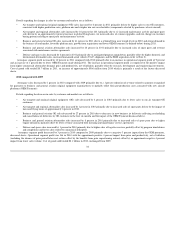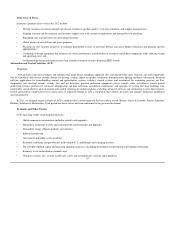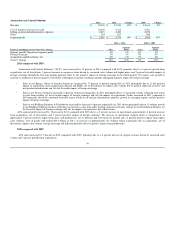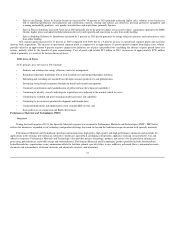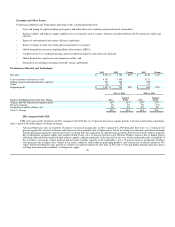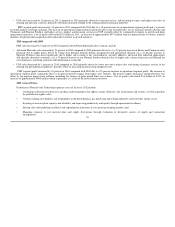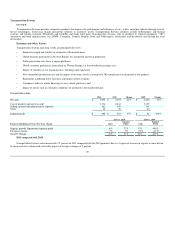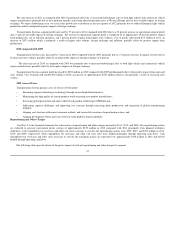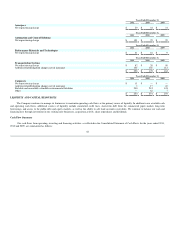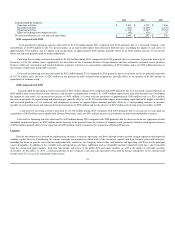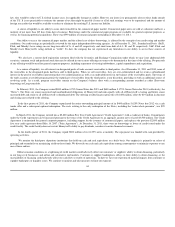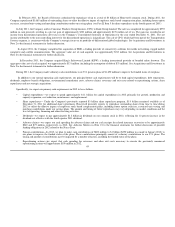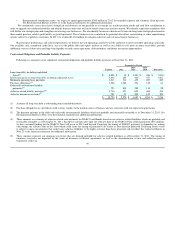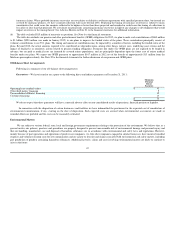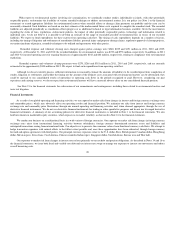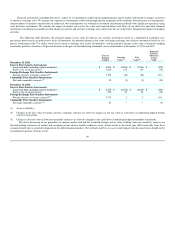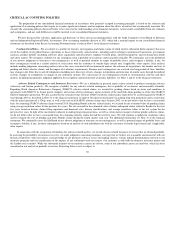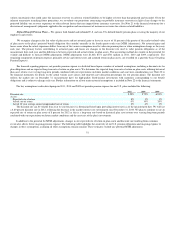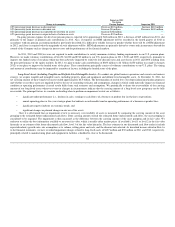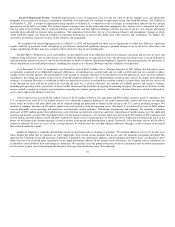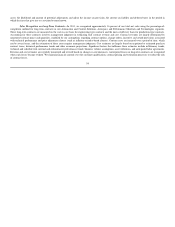Honeywell 2011 Annual Report Download - page 47
Download and view the complete annual report
Please find page 47 of the 2011 Honeywell annual report below. You can navigate through the pages in the report by either clicking on the pages listed below, or by using the keyword search tool below to find specific information within the annual report.
law, they would be subject to U.S. federal income taxes, less applicable foreign tax credits. However, our intent is to permanently reinvest these funds outside
of the U.S. It is not practicable to estimate the amount of tax that might be payable if some or all of such earnings were to be repatriated, and the amount of
foreign tax credits that would be available to reduce or eliminate the resulting U.S. income tax liability.
A source of liquidity is our ability to issue short-term debt in the commercial paper market. Commercial paper notes are sold at a discount and have a
maturity of not more than 365 days from date of issuance. Borrowings under the commercial paper program are available for general corporate purposes as
well as for financing potential acquisitions. There was $599 million of commercial paper outstanding at December 31, 2011.
Our ability to access the commercial paper market, and the related cost of these borrowings, is affected by the strength of our credit rating and market
conditions. Our credit ratings are periodically reviewed by the major independent debt-rating agencies. As of December 31, 2011, Standard and Poor's (S&P),
Fitch, and Moody's have ratings on our long-term debt of A, A and A2 respectively, and short-term debt of A-1, F1 and P1 respectively. S&P, Fitch and
Moody's have Honeywell's rating outlook as "stable". To date, the company has not experienced any limitations in our ability to access these sources of
liquidity.
We also have a current shelf registration statement filed with the Securities and Exchange Commission under which we may issue additional debt
securities, common stock and preferred stock that may be offered in one or more offerings on terms to be determined at the time of the offering. Net proceeds
of any offering would be used for general corporate purposes, including repayment of existing indebtedness, capital expenditures and acquisitions.
As a source of liquidity, we sell interests in designated pools of trade accounts receivables to third parties. As of December 31, 2011 and 2010, none of
the receivables in the designated pools had been sold to third parties. When we sell receivables, they are over-collateralized and we retain a subordinated
interest in the pool of receivables representing that over-collateralization as well as an undivided interest in the balance of the receivables pools. The terms of
the trade accounts receivable program permit the repurchase of receivables from the third parties at our discretion, providing us with an additional source of
revolving credit. As a result, program receivables remain on the Company's balance sheet with a corresponding amount recorded as either Short-term
borrowings or Long-term debt.
In February 2011, the Company issued $800 million 4.25% Senior Notes due 2021 and $600 million 5.375% Senior Notes due 2041 (collectively, the
"Notes"). The Notes are senior unsecured and unsubordinated obligations of Honeywell and rank equally with all of Honeywell's existing and future senior
unsecured debt and senior to all of Honeywell's subordinated debt. The offering resulted in gross proceeds of $1,400 million, offset by $19 million in discount
and closing costs related to the offering.
In the first quarter of 2011, the Company repurchased the entire outstanding principal amount of its $400 million 5.625% Notes due 2012 via a cash
tender offer and a subsequent optional redemption. The costs relating to the early redemption of the Notes, including the "make-whole premium", was $29
million.
In March 2011, the Company entered into a $2,800 million Five Year Credit Agreement ("Credit Agreement") with a syndicate of banks. Commitments
under the Credit Agreement can be increased pursuant to the terms of the Credit Agreement to an aggregate amount not to exceed $3,500 million. The Credit
Agreement is maintained for general corporate purposes, including support for the issuance of commercial paper, and replaces the previous $2,800 million
five year credit agreement dated May 14, 2007 ("Prior Agreement"). At December 31, 2011, there were no borrowings or letters of credit issued under the
credit facility. The credit facility does not restrict Honeywell's ability to pay dividends, nor does it contain financial covenants.
In the fourth quarter of 2011, the Company repaid $500 million of its 6.125% notes at maturity. The repayment was funded with cash provided by
operating activities.
We monitor the third-party depository institutions that hold our cash and cash equivalents on a daily basis. Our emphasis is primarily on safety of
principal and secondarily on maximizing yield on those funds. We diversify our cash and cash equivalents among counterparties to minimize exposure to any
one of these entities.
Global economic conditions or a tightening of credit markets could adversely affect our customers' or suppliers' ability to obtain financing, particularly
in our long-cycle businesses and airline and automotive end markets. Customer or supplier bankruptcies, delays in their ability to obtain financing, or the
unavailability of financing could adversely affect our cash flow or results of operations. To date we have not experienced material impacts from customer or
supplier bankruptcy or liquidity issues. We continue to monitor and take measures to limit our exposure.
44


